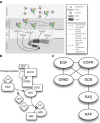Topology of molecular interaction networks
- PMID: 24041013
- PMCID: PMC4231395
- DOI: 10.1186/1752-0509-7-90
Topology of molecular interaction networks
Abstract
Molecular interactions are often represented as network models which have become the common language of many areas of biology. Graphs serve as convenient mathematical representations of network models and have themselves become objects of study. Their topology has been intensively researched over the last decade after evidence was found that they share underlying design principles with many other types of networks.Initial studies suggested that molecular interaction network topology is related to biological function and evolution. However, further whole-network analyses did not lead to a unified view on what this relation may look like, with conclusions highly dependent on the type of molecular interactions considered and the metrics used to study them. It is unclear whether global network topology drives function, as suggested by some researchers, or whether it is simply a byproduct of evolution or even an artefact of representing complex molecular interaction networks as graphs.Nevertheless, network biology has progressed significantly over the last years. We review the literature, focusing on two major developments. First, realizing that molecular interaction networks can be naturally decomposed into subsystems (such as modules and pathways), topology is increasingly studied locally rather than globally. Second, there is a move from a descriptive approach to a predictive one: rather than correlating biological network topology to generic properties such as robustness, it is used to predict specific functions or phenotypes.Taken together, this change in focus from globally descriptive to locally predictive points to new avenues of research. In particular, multi-scale approaches are developments promising to drive the study of molecular interaction networks further.
Figures


Similar articles
-
Macromolecular crowding: chemistry and physics meet biology (Ascona, Switzerland, 10-14 June 2012).Phys Biol. 2013 Aug;10(4):040301. doi: 10.1088/1478-3975/10/4/040301. Epub 2013 Aug 2. Phys Biol. 2013. PMID: 23912807
-
Folic acid supplementation and malaria susceptibility and severity among people taking antifolate antimalarial drugs in endemic areas.Cochrane Database Syst Rev. 2022 Feb 1;2(2022):CD014217. doi: 10.1002/14651858.CD014217. Cochrane Database Syst Rev. 2022. PMID: 36321557 Free PMC article.
-
Use of systems biology to decipher host-pathogen interaction networks and predict biomarkers.Clin Microbiol Infect. 2016 Jul;22(7):600-6. doi: 10.1016/j.cmi.2016.04.014. Epub 2016 Apr 22. Clin Microbiol Infect. 2016. PMID: 27113568 Review.
-
Targeting and tinkering with interaction networks.Nat Chem Biol. 2008 Nov;4(11):666-73. doi: 10.1038/nchembio.119. Nat Chem Biol. 2008. PMID: 18936751 Review.
-
Dynamic and structural constraints in signal propagation by regulatory networks.Mol Biosyst. 2013 Feb 2;9(2):268-84. doi: 10.1039/c2mb25243k. Epub 2012 Dec 6. Mol Biosyst. 2013. PMID: 23224050
Cited by
-
Methods for biological data integration: perspectives and challenges.J R Soc Interface. 2015 Nov 6;12(112):20150571. doi: 10.1098/rsif.2015.0571. J R Soc Interface. 2015. PMID: 26490630 Free PMC article. Review.
-
Supervised clustering based on DPClusO: prediction of plant-disease relations using Jamu formulas of KNApSAcK database.Biomed Res Int. 2014;2014:831751. doi: 10.1155/2014/831751. Epub 2014 Apr 7. Biomed Res Int. 2014. PMID: 24804251 Free PMC article.
-
Quantitative Analysis of Robustness of Dynamic Response and Signal Transfer in Insulin mediated PI3K/AKT Pathway.Comput Chem Eng. 2014 Dec 4;71:715-727. doi: 10.1016/j.compchemeng.2014.07.018. Comput Chem Eng. 2014. PMID: 25506104 Free PMC article.
-
Hypergraph-based connectivity measures for signaling pathway topologies.PLoS Comput Biol. 2019 Oct 25;15(10):e1007384. doi: 10.1371/journal.pcbi.1007384. eCollection 2019 Oct. PLoS Comput Biol. 2019. PMID: 31652258 Free PMC article.
-
Flux-dependent graphs for metabolic networks.NPJ Syst Biol Appl. 2018 Aug 14;4:32. doi: 10.1038/s41540-018-0067-y. eCollection 2018. NPJ Syst Biol Appl. 2018. PMID: 30131869 Free PMC article.
References
-
- Orchard S, Kerrien S, Abbani S, Aranda B, Bhate J, Bidwell S, Bridge A, Briganti L, Brinkman F, Cesareni G, Chatr-aryamontri A, Chautard E, Chen C, Dumousseau M, Goll J, Hancock R, Hannick L, Jurisica I, Khadake J, Lynn D, Mahadevan U, Perfetto L, Raghunath A, Ricard-Blum S, Roechert B, Salwinski L, Stumpflen V, Tyers M, Uetz P, Xenarios I. et al.Protein interaction data curation: The international molecular exchange (IMEx) consortium. Nat Methods. 2012;9:345–350. doi: 10.1038/nmeth.1931. - DOI - PMC - PubMed
Publication types
MeSH terms
LinkOut - more resources
Full Text Sources
Other Literature Sources

